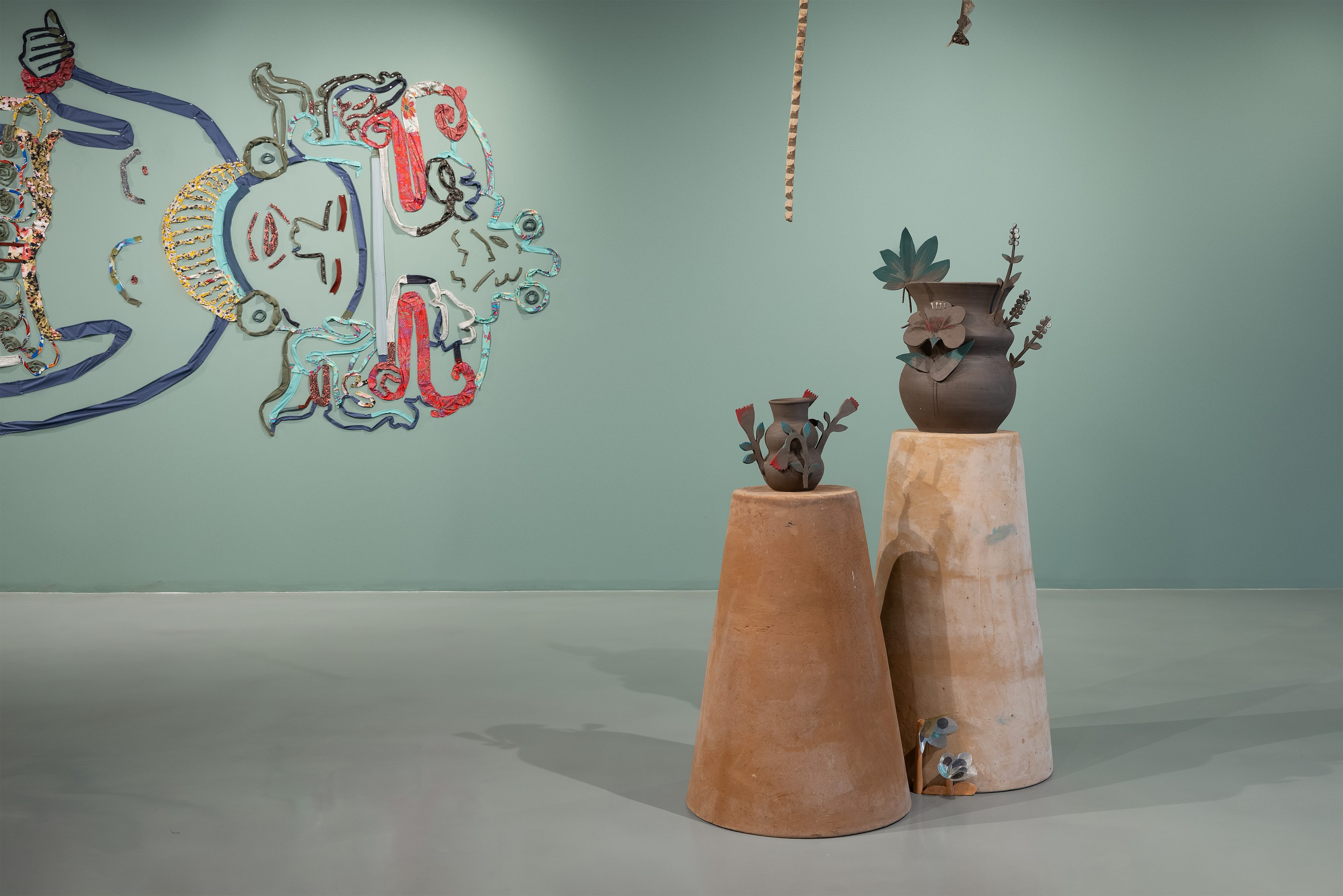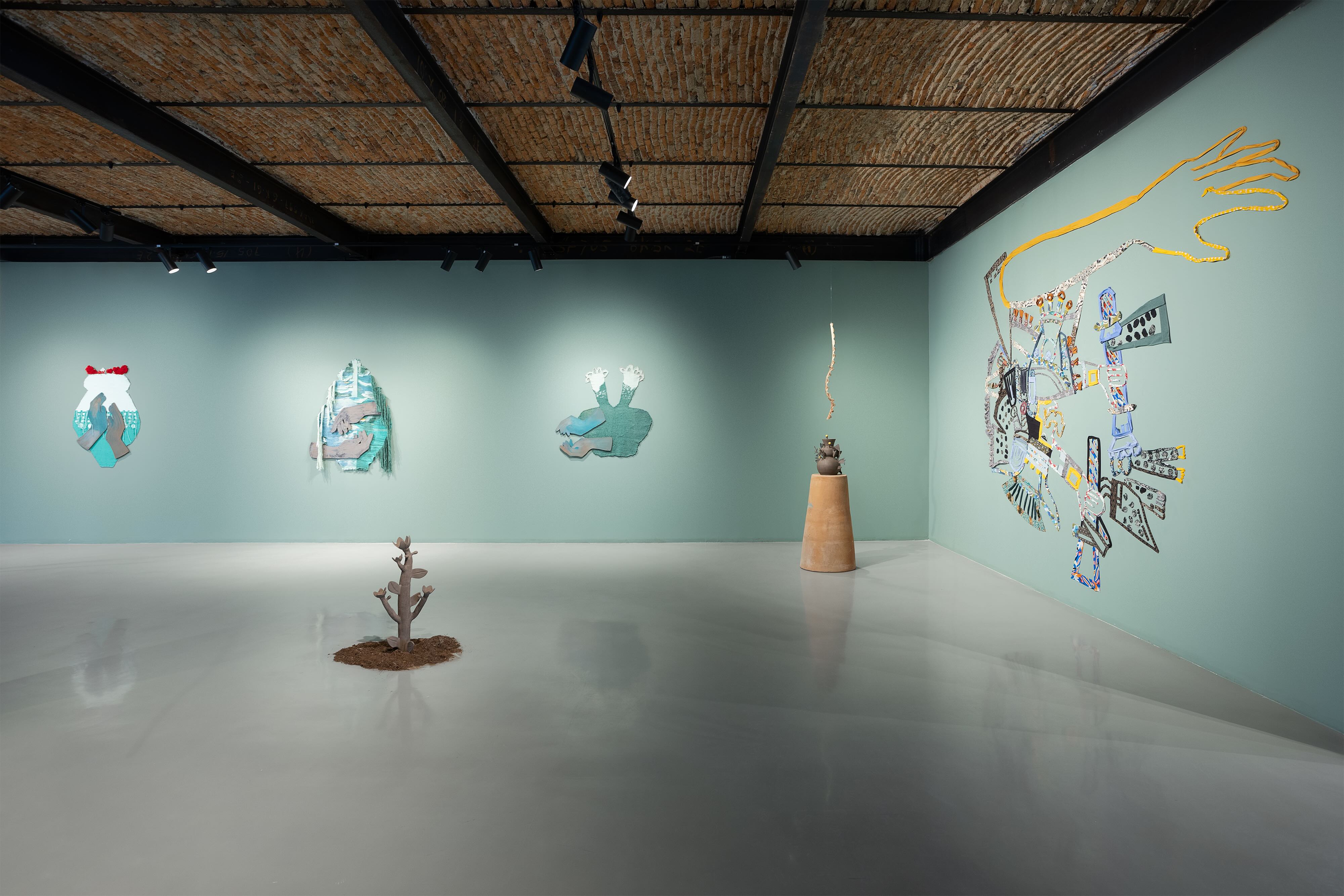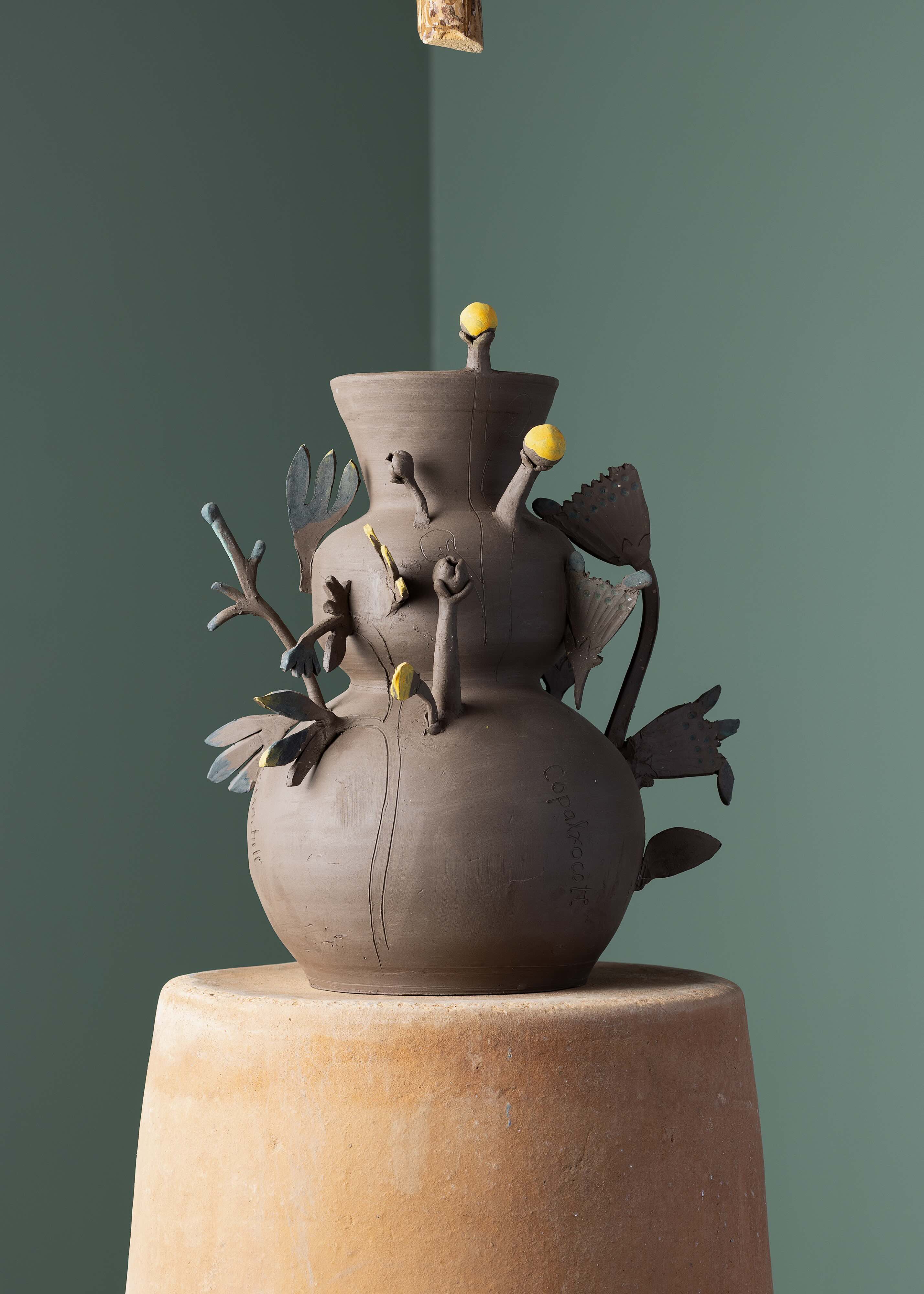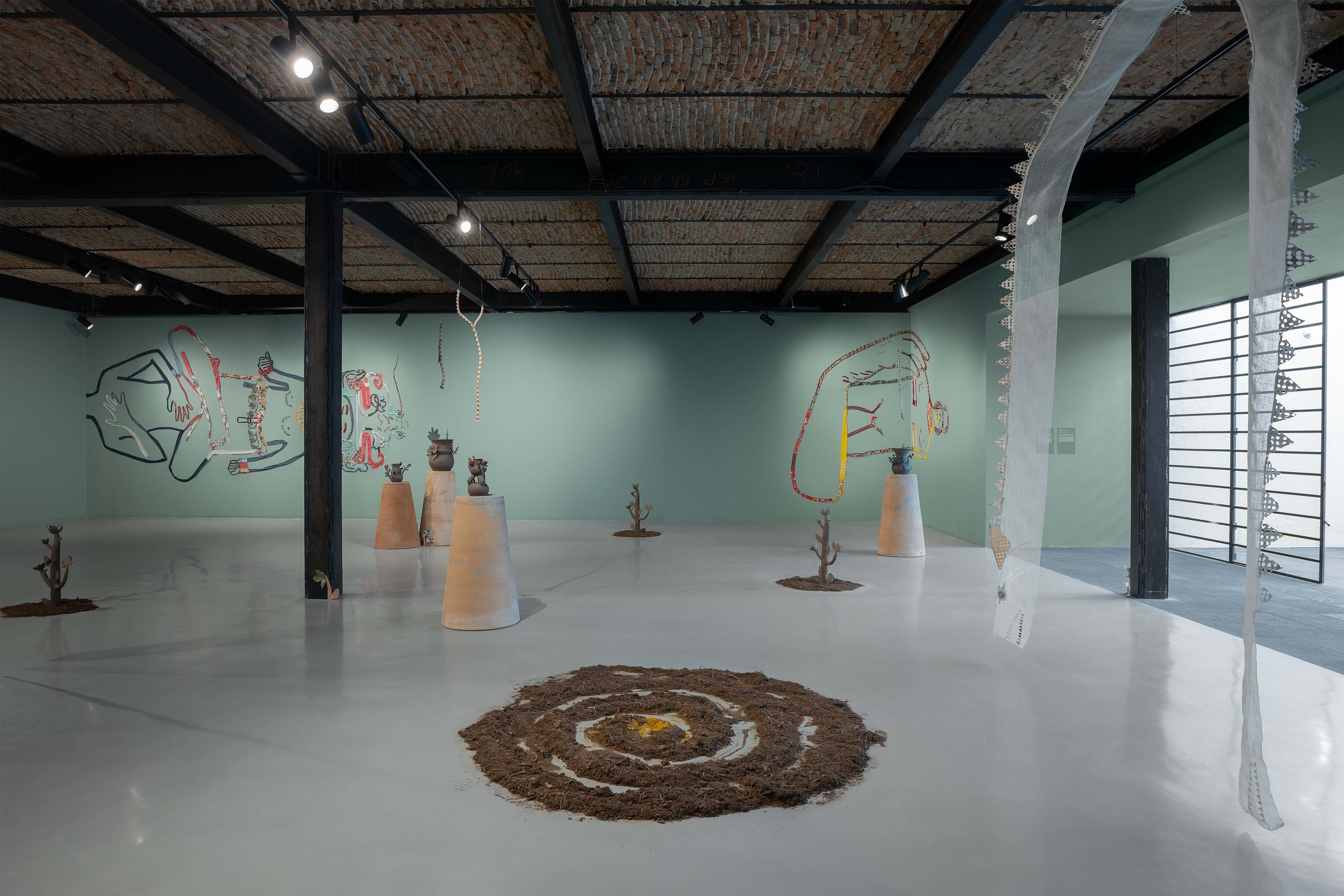
Review
Notes on a Colonial Gaze in "Di tu nombre tres veces" by María Sosa at Plataforma
by Maya Renée Escárcega
Reading time
11 min
Preamble
Certain concepts and categories are so broad and imprecise that they become vague, lose depth, or blur in their critical capacity. Even in fields of thought rooted in questioning and resistance, the use of jargon without contextual or situated grounding can build essentialist narratives steeped in nostalgia for an idealized past. Such abstraction creates a fracture: on the one hand, it distances those who sympathize with these frameworks when they are approached rigorously; on the other, it reinforces the skepticism of those who see them as “performative gestures.”
This is why the work of Homi K. Bhabha remains relevant in post/colonial studies, where he explores ideas like hybridity, ambivalence, and others that escape binary logics (West/East, White/Black). Or the writings of contemporary voices like Yásnaya Elena Aguilar, who dismantles the notion of Mexico as a nation-state and argues that categories like “Indigenous” are forms of coloniality. In the same tone, Olivier Debroise argued that the concept of “mestizo” is a form of appropriation that diminishes the present reality of original nations—particularly significant in states like Jalisco, where historiography “knows” and “teaches” very little about its pre-Columbian past. There, cultural identity was built primarily from 19th and 20th-century nationalist narratives. Navigating this terrain of identity and history, María Sosa’s exhibition at Plataforma offers visitors a moment of healing from a wound, but also a critical look at a biased and colonial past, aiming to overflow, crack open, and liberate categories within academic and artistic discourse.
This reflection opens two paths toward the origin of this project:
The first concerns silences. It’s common to come across the term “enigmatic” to describe vast periods and regions of Western Mexico, as Mesoamerican studies have largely focused on the central highlands and southern areas—compounded by the looting of material records. In the face of that void, María Sosa articulates rigorous research, a sensitive artistic practice, and deep empathy with her surroundings to address the epistemicides of pre-Hispanic worlds, revealing non-Western ways of life and knowledge. In her practice, the systematic destruction of knowledge operates as a methodology. On one hand, she carries out “amateur” archaeological readings (inference in Baxandall’s key), grounded in her visual knowledge—a vast compendium that allows her to dissect images from sources such as codices and archaeological figures. On the other hand, she conducts research through art via bodily explorations from an intimate and situated place that allows her to engage with different aspects of the past. In that sense, bringing Pre-Hispanic art into her artistic practice and into our present is not an exercise of representation, but rather one of updating, which allows her to disseminate other sensibilities and undermine the current system.
The second path is more urgent. This project arose from the need to find a way to confront the markers of violence and express grief for the mounting, nameless absences in a hostile climate for freedom of thought—a political moment in which the sitting government (2018–2024) polarized thinking into dichotomies such as good and bad, Spanish and Indigenous. As is well known, not all critiques of supposedly progressive discourse come from conservative positions. Sosa also observed the superficial adoption of categories in the artistic and academic fields, where they operate without real commitment and with a lack of self-monitoring: calling oneself decolonial, even when one’s personal relationships and professional practices never leave the realm of theory.

Yesterday, an urn merged with the shadow of a tree,
Today, a conversation with the grandmother
It’s sometimes forgotten that cycles, by definition—even etymologically—are circular. Especially the life cycle, since in secular Western conceptions, each phase is a transformation leading to the end of individual existence. It only restarts through other forms of life derived from reproduction, genetics, or bodily decomposition and reintegration into other cycles.
This body of work began a year earlier, when an urn joined a shadow. In 2024, María Sosa presented ¿Qué has hecho con nuestro cuerpo, que era morada de los dioses? [What Have You Done with Our Body, Which Was the Dwelling of the Gods?] at the Juan Soriano Contemporary Art Museum of Morelos (MMAC). The exhibition brought together a series of dark vessels proposing a reading of the body as a container of ancestral stories, “given to us at birth and taken from us at death.” Textile-crafted hands and feet accompanied the ceramic pieces, along with wool and hair applications. In a condensed and veiled manner, this first chapter addressed a deep concern about the disappearance of the body and the desire to connect with the dead. Veiled, because it acknowledges the danger and respect warranted when speaking of the crisis of disappearances in Mexico.
Through funerary urns, Sosa reflected that the life cycle does not end with death and tasked herself with seeking the life-force of beings who have passed through it—as spirits, ghosts, or apparitions. Her focus was not on resurrection but on how the devaluation of death leads to the devaluation of life. In this context, these energies can be thought of as aparecidos (ghostly presences).
The shadow is one of the mediums of the dead. At the MMAC, when the shadow of a tree fell over the funerary urns, the artist knew her message had been received: ✓✓.
In Di tu nombre tres veces [Say Your Name Three Times], an exhibition curated by Agustín Pérez Rubio, the artist continues this conversation with a healing tone, reflected in the emerging vegetation in the first-floor gallery at Plataforma. The installation forms a kind of garden of affectations. The project addresses the transition to the afterlife through tubes, staircases, and portals—manifesting as vessels, arches, and textile murals.

Inspired by Capacha tradition vessels from Western Mexico—an “enigmatic” culture that inhabited Colima from 1200 to 500 BCE—Sosa presents ceramics that emulate gourds: monochrome triple-globular-body jugs, horizontally divided at the waist and decorated with incisions. Instead of lines or dot motifs, Sosa’s urns carry inscriptions in Nahuatl and botanical motifs, both incised and modeled. The species come from the Codex De la Cruz-Badiano, the first treatise on medicinal properties and herbal knowledge of the Mexica. Through these, the Mesoamerican conception of illness is illuminated, in which biological, emotional, and social deterioration are not fragmented. Ailments such as shyness, imbalance caused by bad winds, or the pungent smell of armpits are treated through a holistic sensitivity. In Vasija para convocar un remedio de ayuda para el viajero [Urn to Summon a Remedy to Aid the Traveler] (2024), the inscription “Copalxocotl” is accompanied by yellow flowers of the copaljocote, a tree endemic to Tierra Caliente—and six other urns summon remedies for the battered body, heart heat, insomnia or interrupted sleep, heartache, eye heat, and excess body heat.
An eighth urn addresses the life-death cycle. Its upper and lower bodies are connected by three tubes evoking the trifid vessels of the Capacha tradition, objects linked exclusively to funerary contexts since their identification in 1980. Vasija para convocar un remedio contra el miedo [Urn to Summon a Remedy Against Fear] (2024) stems from the relationship between the womb and the uterus explored in studies on shaft tombs. The artist conceives the tubes as channels in the earth: through them, the child is born downward, and the dead ascend to another plane.
Suspended above the urns is a striated wooden carving called si’piraka. Translated as “scraper,” this tool is used to scrape jíkuri (peyote). Though known as a musical instrument, its primary function is healing. In Rarámuri cosmology, illness arises from conflicts or a bad relationship with the jíkuri, which then kidnaps the soul and takes it to the Chihuahua desert—regardless of whether one is a child, adult, or deceased. When the transgressor gradually loses vital energy, suffering grave physical and emotional consequences, the Rarámuri shaman (si’pame) uses the si’piraka to negotiate diplomatically with these plant-beings. In Hacer surgir las escaleras cósmicas [To Summon the Cosmic Stairs] (2024), the si’piraka assumes the role of path-staircase, linked to the soul’s movement during healing: a staircase because every path rises and falls—especially the sun on its journey. A clay specimen survives, ending in a snake’s head. In Rarámuri iconography, the snake belongs to the same semantic field of path-staircase, up-down. In Sosa’s work, the cosmic staircase is used to summon dialogue between the earthly and the beyond.
On green walls and around the garden, the murals Debajo de nuestra piel, Cihuateteo (2025), Debajo de nuestra piel, Chalchihuitlicue (2025) y Debajo de nuestra piel, Deidad Madre (2025) [Under Our Skin, Cihuateteo; Under Our Skin, Chalchihuitlicue; and Under Our Skin, Mother Deity] portray deities represented in codices and archaeological ceramics of pregnant women. Formed with the artist’s own clothing, they allude to witchcraft practices that use textiles imbued with the essence of the wearer. These pieces invite viewers to find those entities within their own skin, bodies, and dreams, as well as through personal approaches to the supernatural. As in the urns, pregnancy appears here as a liminal state. In the pre-Hispanic worldview, the fetus was a midpoint between demon and deity—a baby was not yet a person; personhood came with the acquisition of social behavioral values.
_9_50_57%E2%80%AFa_m_.jpeg?alt=media&token=1b746570-257b-4ed6-9ffb-c3a711ea7218)
With Sanar tus palabras (2024), Sanar tu energía (2024) y Sanar tu muerte [Healing Your Words, Healing Your Energy, and Healing Your Death] the artist initiates another conversation around healing, this time with her deceased grandmother. The hands evoke a shared game in which they placed their hands one over the other without touching—a gesture also found in Eastern practices like Tai Chi. One day, they generated a dense energy sphere that frightened her grandmother, who forbade her from repeating it (in binary thinking, what is not from God must be from the devil). Years later, in Cherán, Sosa learned a similar technique that allowed her to feel the energy in the environment.
During the opening, the artist drew a petroglyph on the earth, shaping Espiral [Spiral] (2025). This symbol, present in various Mesoamerican cultures, represents the cyclical regeneration of life and death, as well as the transit between planes: the underworld, the overworld, and the earthly realm. Due to its presence on figurines of pregnant women, it has been associated with fertility and rebirth, and is also frequently linked to the figure of the two-headed serpent. Thus, the spiral traced by the artist on the ground becomes a womb that connects the underworld to the surface, summoning the energy of the earth and a time and cycle that are not linear.

Entrar en la piel [Entering the Skin] (2025) opens a portal that does not conclude in Salir de la piel [Exiting the Skin] (2025). Like the spiral, it represents the passage between life and death through two-headed serpents arranged in infinity across textile arcades of ixtle (maguey fiber). A Hñähñu master affirms that the ayate (woven ixtle) is the place “where we are born and where we die.” Thus, the looms symbolize both human skin and the skin of the cosmos—a possible phantom skin.
As a gesture honoring the cyclical nature of the exhibition, we return to the start of the tour. Among the bases supporting the vessels, thirteen ceramic flowers grow like weeds: Sanar la mirada [Healing the Gaze] (2025). Unlike other plants, many of which have been domesticated since pre-Columbian times, weeds grow without permission. The petals made of metallic fabric allude to the introductory piece in the antechamber: El señor de la mirada colonial [The Lord of the Colonial Gaze] (2024).
Like the Lord of COVID—an entity crafted by spiritual specialists during the pandemic to eliminate the virus—Sosa created a figure to heal the infection of the “colonial gaze”: a polarizing vision that, among other harms, sees human, plant, and animal bodies as resources for the king’s profit. The image, like a voodoo doll with multiple eyes, refers to the multiplicity of subjects seen through that gaze. Its materiality—metallic mesh—functions as a filter through which everything is viewed in terms of gold and silver, historical engines of conquest.
The exhibition underscores the urgency of creating liminal spaces: portals to converse with the departed and our loved ones; in-between realms to understand life and death; conceptual specters to nuance thought; passages between planes and between ourselves; stairways for learning with others—even when the other is Western, like archaeology and ethnography. The operation is a constant putting on and taking off of the lens. With tonal precision, Sosa proposes healing tools from the Rarámuri and Mexica traditions, as well as from intimate and affective experience, to restore the links between body and energy, past and present. Healing the gaze by returning agency to the sensible, healing language by speaking with our ancestors… Sosa is very good with nuance.
Translated to English by Luis Sokol
Published on May 18 2025